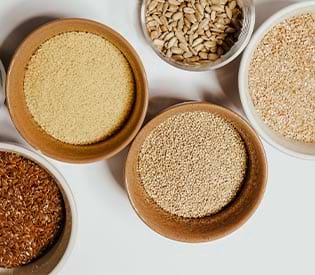Tansy Herb
📦🚚 Fast & Free shipping on all orders
What is tansy herb?
Tansy, originally from Europe, made its way to North America as an ornamental or for traditional medicinal purposes. It is a prevalent intruder on roadsides and in waste areas across temperate regions of North America, where it inhabits disturbed sites. Multiple states designate tansy as a "noxious weed." Tanacetum vulgare, a member of the Asteraceae family, has brilliant yellow button-shaped blooms and leaves that are like sharp ferns. Because of its many health benefits, tansy, which is native to both Europe and Asia, has long been used in traditional European herbalism. It has also been applied as a textile dye. Tansy herb is useful for topical treatments as well as infusions and washes.
Native to temperate regions of Asia and Europe, tansy Tansy is an invasive species in some countries where it was introduced. All the same, this herbaceous perennial with yellow blooms that resemble buttons is also a mainstay in many gardens. Ancient Greece is only one of the many historical uses of tansy. Old folk herbal therapies often used the plant in infusions, external application washes, and even as a textile dye. Tanacetum, the scientific name for tansy, is believed to be derived from the Greek word athanasia, which means "immortality." Although we can only surmise, we are not certain what the ancient Greeks were alluding to. Tansy is a plant with long-lasting yellow flower heads and seeds that seem to endure forever, even during the winter. Furthermore, the herb's scientific name may allude to its traditional usage in burial customs and the preservation of deceased people's remains.
Tanacetum vulgare is a member of the sunflower family, or Asteraceae family. The plant has pinnate, finely split leaves that alternate along the stem and resemble ferns. Tansy produces yellow, button-shaped, persistent flower heads studded with hundreds of disc blooms. It is common to characterize the scented aerial sections of the plant as camphoraceous with a touch of rosemary. One potent chemical ingredient found in the leaves and flowers is thujone, which is a volatile oil.
How do I use tansy herb?
For scabies, itching, bruising, sores, sprains, swelling, freckles, inflammation, vaginal discharge, sunburn, toothache, and tumors, apply tansy directly to the afflicted region. Additionally, people apply it topically to repel insects. Tansy is a flavoring ingredient used in food and drink products.
Tansy herb benefits:
People used tansy to induce measles and cure rheumatism, intestinal worms, fevers, sores, and digestive issues. Abortions were induced with large dosages both during and after the Middle Ages. Tansy, on the other hand, was also utilized to aid in conception and stop miscarriages in women.
◉ Anti-inflammatory properties: The potential of blue tansy oil to lower inflammation has not been thoroughly studied. However, there is some evidence that two of its primary ingredients may effectively reduce inflammation.
◉ Skin-healing effects: Blue tansy oil's high camphor content has been shown to aid in the healing of injured skin. In one study, camphor treatment resulted in improvements in mice exposed to UV light. As a result, scientists hypothesized that camphor would be a powerful agent for mending wounds and perhaps preventing wrinkles.
◉ Antihistamine properties: Blue tansy has been used as an antihistamine to lessen nasal congestion in traditional Chinese medicine. To make infused steam, aromatherapists advise adding a few drops to a bowl of very hot water.
◉ Prevents Bacterial Infections: It should not be too difficult to comprehend that those small germs would also die from the essential oil, which is very toxic and may be lethal to people. While certain bacteria can withstand unfathomable temperatures and poisons, this oil is fatal to the majority of bacteria found in the human body. Tannic oil kills them and prevents their ability to reproduce. If taken in extremely small amounts, this provides good protection against bacterial infections.
Where can I buy tansy herb?
Buy tansy herb from the health food store in the USA, Alive Herbals.
Tansy herb information (at a glance):
| Product Name | Tansy Herb |
| Scientific Name | Tanacetum vulgare L. |
| Country of Origin | It is native to Eurasia |
| Ingredient | Tansy Herb. |
| Taste & Aroma | Aroma: smells of resin and balsam. Taste: very bitter |
| Shelf Life & Storage | Shelf life is about 6–36 months. Store it in an airtight container in a cool, dry place and prevent sunlight exposure. |
| Precautions | We requested that, Before consuming spices, herbs, teas or any kind of natural products, you consult an expert qualified healthcare practitioner or herbalist. |
| Note | This product information has not been appraised by the Food and Drug Administration (FDA). This information is solely intended for educational purposes. |







